
 |
Eager Space | Videos by Alpha | Videos by Date | All Video Text | Support | Community | About |
|---|

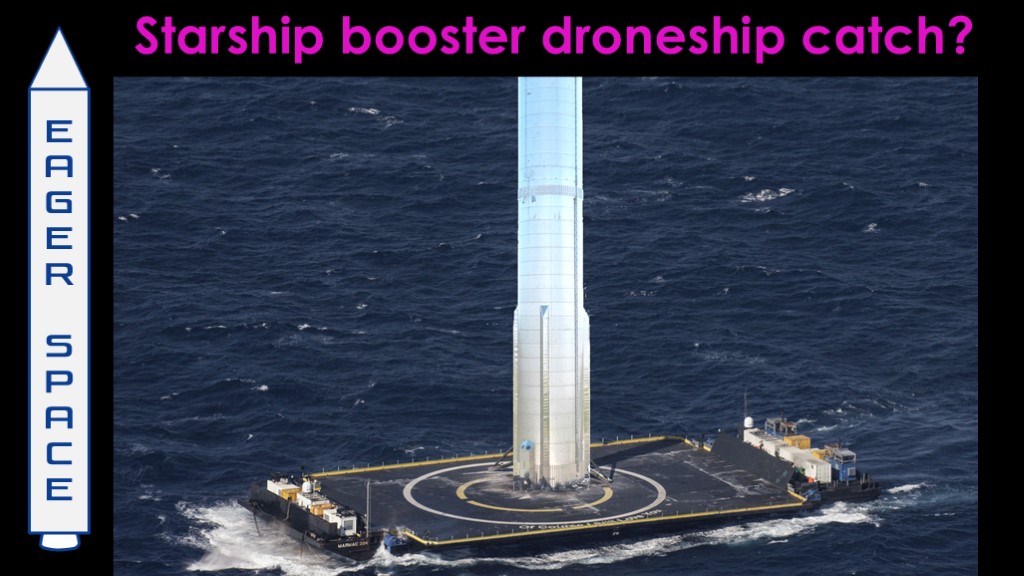
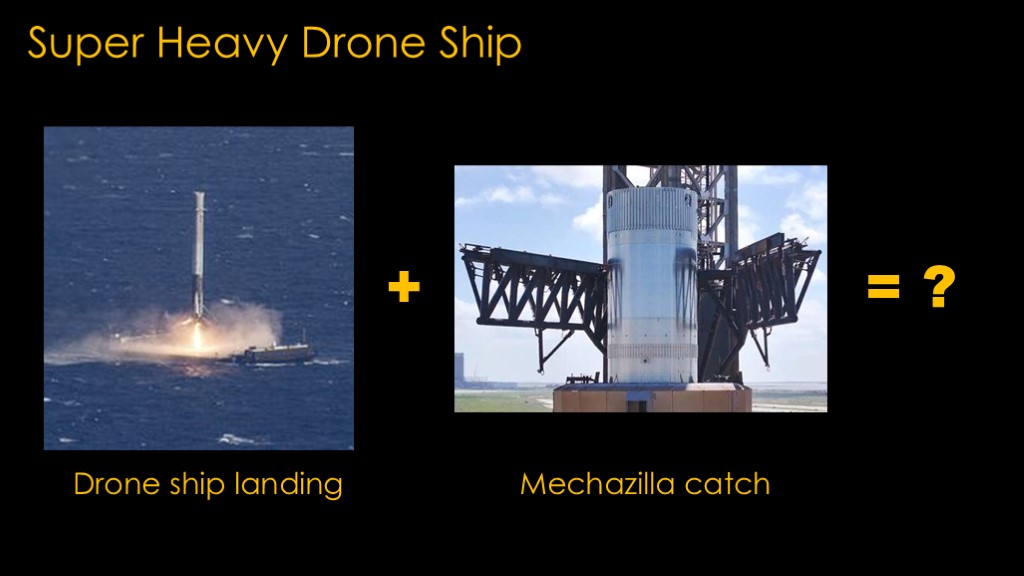
We know that drone ship booster landings are the primary reuse method for Falcon 9, and these days it seems like one is happening all the time. The drone ship reuse architecture has been pivotal in SpaceX's reuse model.
And yet, for Starship, SpaceX has abandoned the drone ship model and gone solely with the return to launch site model, where the booster will be caught by a large set of arms known as mechazilla.
We know that using return to launch site with Falcon 9 has a significant payload cost, and that should be true for starship. Why would SpaceX stop using drone ships? It just doesn't add up.
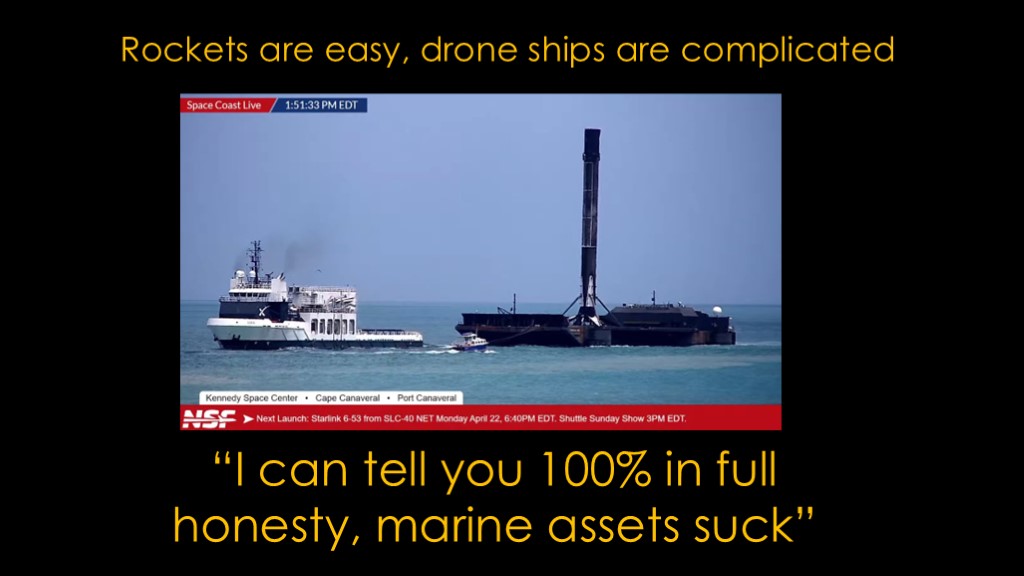
I hadn't dug deeply into the marine operations side of SpaceX, and after a fair bit of research, I have come to the conclusion that rockets are easy to analyze, and drone ships are complicated.
Or, as Rocket Lab CEO Peter Beck famously said, "I can tell you 100% in full honesty, marine assets suck". And initially the plan for rocket lab's Neutron rocket was to always do return to launch site, but they have since decided to land downrange on a drone ship.
We're going to have to spend a bit of time understanding why Falcon 9 uses drone ship recovery, how it is done, and then we'll talk about why Starship - at least currently - will always fly the booster back to the launch site.
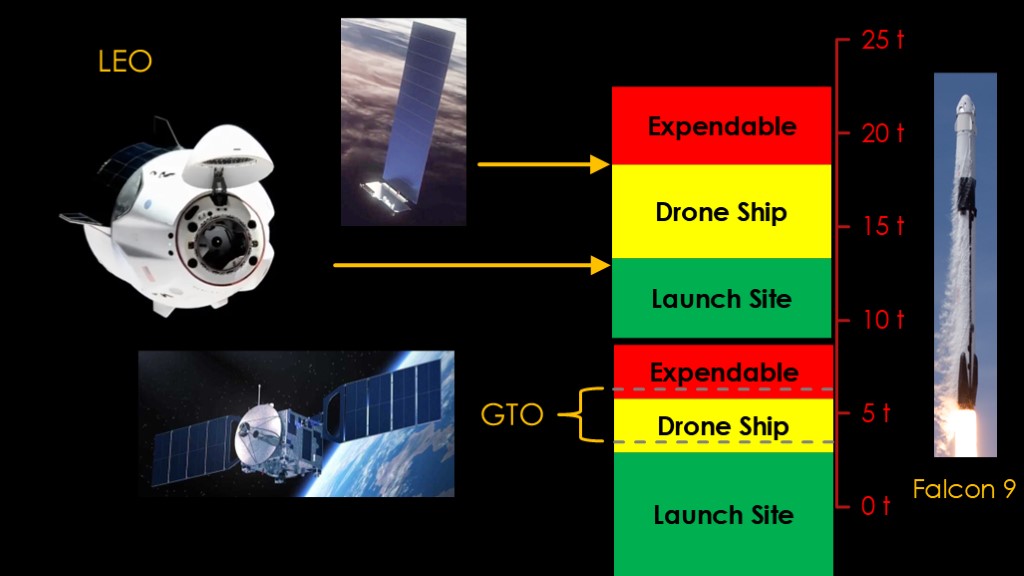
For Falcon 9, it all comes down to payload capabilities.
One of the main goals of Falcon 9 was to be able to launch communications satellites to geosynchronous transfer orbit. Those payloads are roughly in the 3-7 ton range. If we add in the payload capability of Falcon 9 to those orbits, we see that those missions cannot be flow with a return to launch site, and if you want reuse, you need to go with the drone ship.
For low earth orbit launches, the situation is a little better. Current crew and cargo dragon flights are able to sneak in just under the limit and can fly return to launch site missions, but earlier versions Falcon 9 had slightly less performance and SpaceX kept larger performance margins and therefore the dragon missions were flown with drone ship recovery. It probably made NASA happier as well.
Starlink missions carry enough satellites to be right up at the payload limit for a drone ship landing.
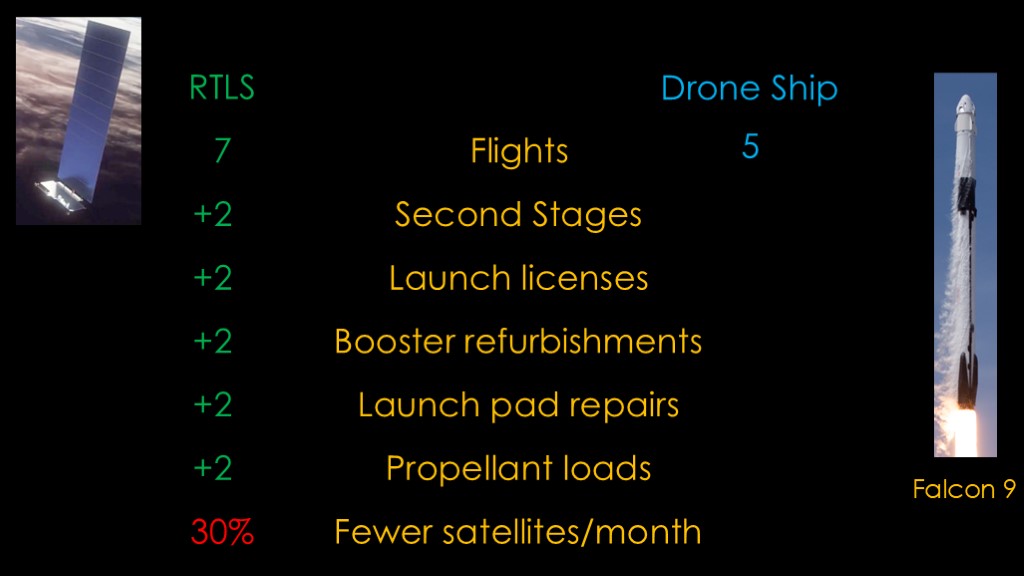
Starlink seems like the perfect place to use return to launch site. It would take 7 flights to carry the same number of satellites that could be carried with 5 drone ship launches, but it would be a lot simpler...
But those two more flights mean two more second stages, launch license, booster refurbishments, launch pad repairs, and propellant loads.
It would also mean - for a given flight rate - about 30% fewer satellites into orbit per month.
My guess is that those extra two flights - and especially the cost of the two extra second stages - means that RTLS costs a little more, but I think the big driver is the number of satellites per month.
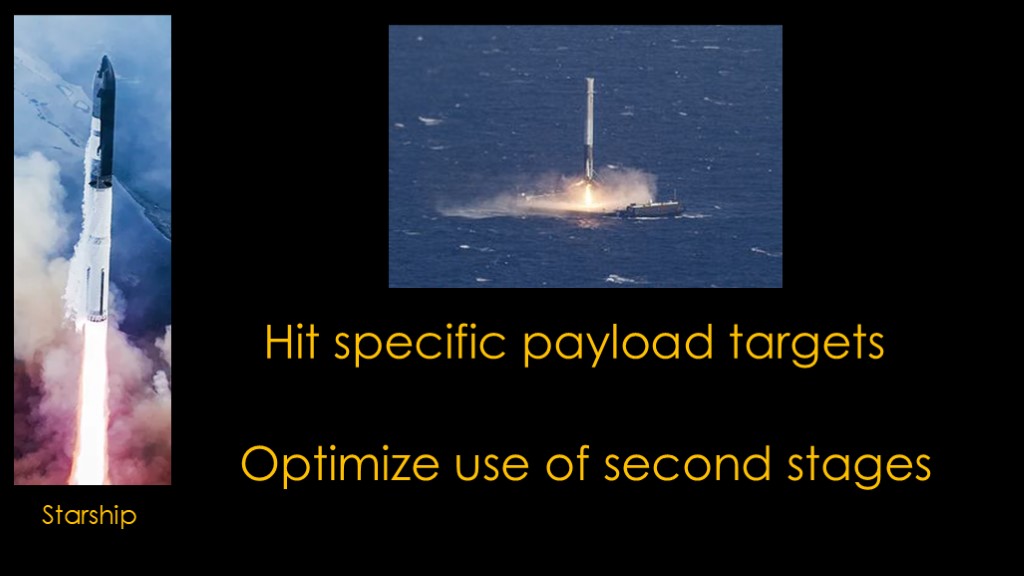
To summarize, drone ship landing allowed SpaceX to do two important things with Falcon 9. They could hit specific payload targets and launch payloads that they could not carry with return to launch site landings, and they could get the maximum payload out of the second stage that they expend on every flight.
But starship is a different beast. It has sufficient performance to carry all current payloads, and it is fully reusable, so the Falcon 9 second stage concern does not apply.
To understand why starship isn't doing drone ship landing, we need to understand more about the SpaceX fleet
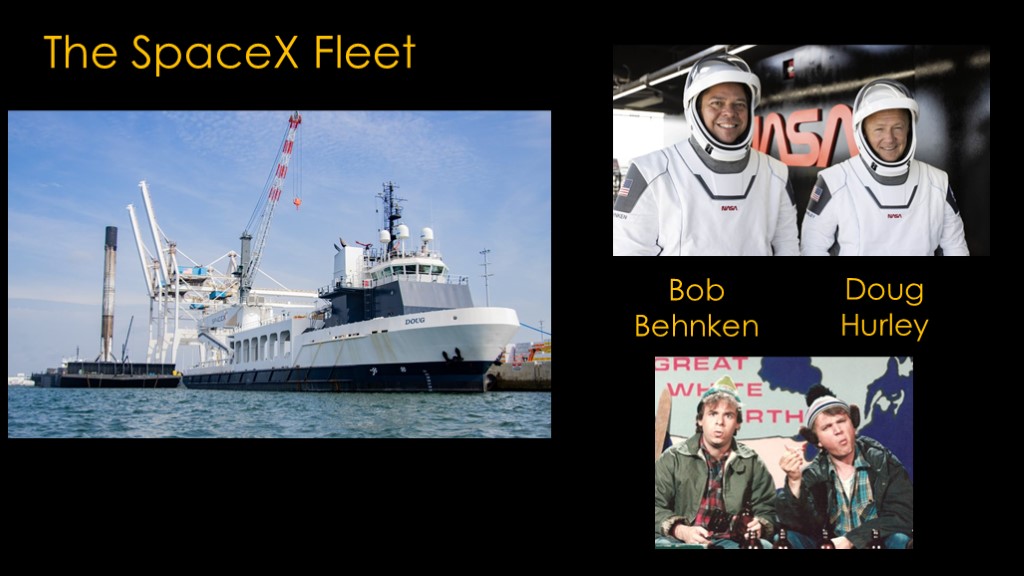
The SpaceX drone ships in Florida are paired with support vessels that go out to assist and also to retrieve fairings. The support ships are named Bob and Doug after the two astronauts who flew the first crew dragon mission to the international space station, not after Bob and Doug McKenzie from the great white north.
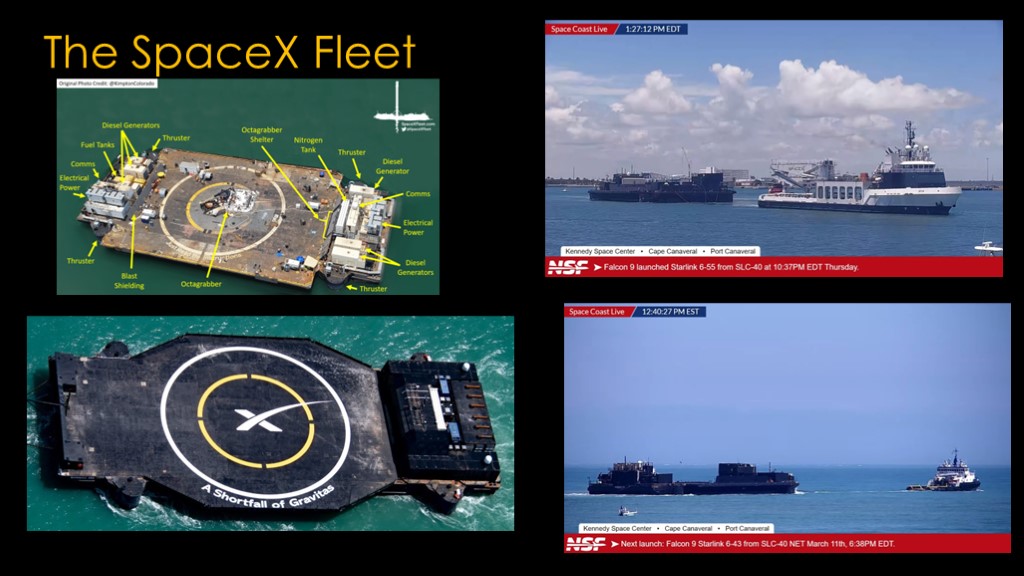
The drone ships have thrusters in the four corners that keep them on station so the boosters know where to find them. That is why they are called "autonomous drone ships" - they can stay where they need to be without people on board.
The newest droneship - a shortfall of gravitas - has onboard propulsion to take it to the catch location and back, but SpaceX has not used that capability yet.
Drone ships therefore needs to be towed. They can be towed by either Bob or Doug, but bob and doug also have fairing retrieval duties that require them to be in a slightly different position from the drone ship and each ship can carry 4 fairings so they will generally stay out for more than one mission, That means SpaceX will often pay a tug to carry a drone ship out to the proper location and back to port.
And then it's just a matter of setting up a steady cadence for all the ships and everything runs smoothly...
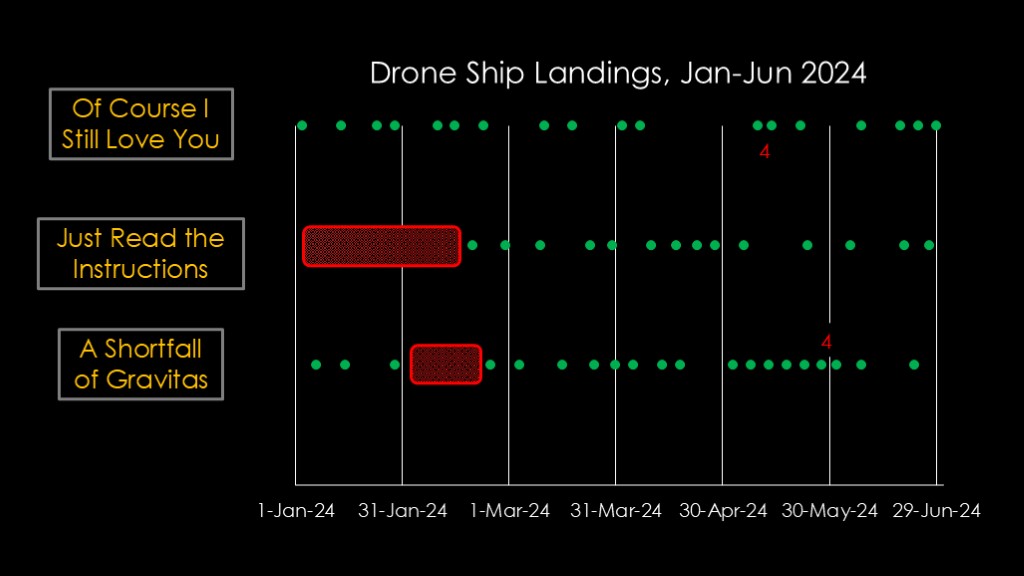
That of course is not true, because nothing is simple with marine assets.
This graph shows all the drone ship landings for the first half of 2024 after SpaceX has had a few years to tune their system for efficiency. Note that it's not showing the use of the support ships or tugs.
The top section shows the drone ship Of course I still love you, which operates out of long beach in California for launches from Vandenberg.
Just read the instructions and a shortfall of gravitas both operate out of port Canaveral in Florida.
We can figure out a few things. The first is that the shortest turnaround from one landing to the next is 4 days, but those are uncommon and 5 days between landings tends to be the shortest times.
There are also gaps big and small when a drone ship isn't operating.
Across the fleet average about one landing every 10 days, or about half of their maximum rate.
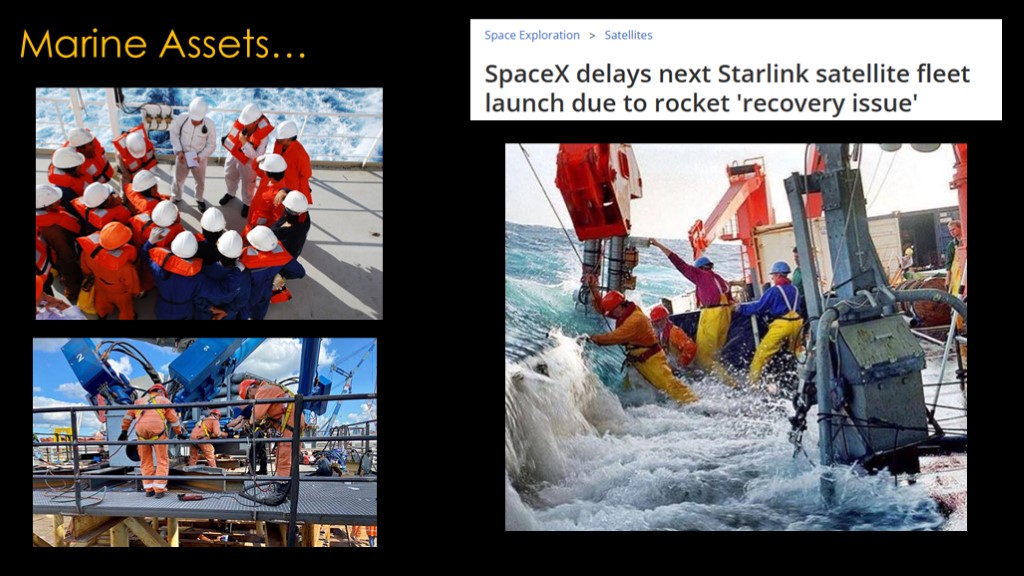
Remember what peter beck said about marine assets...
While it is common for ship's crew to work a month without a day off, eventually they will need downtime, and that is one factor that leads to the slower rate.
And the ship will need downtime to conduct regular maintenance, repair, and upgrades
And finally, the weather is always a factor. If it's not safe for the drone ship and support ships to be out there, the flight has to be delayed, and even with acceptable conditions, the weather can increase the time to get to the landing point or return to port.
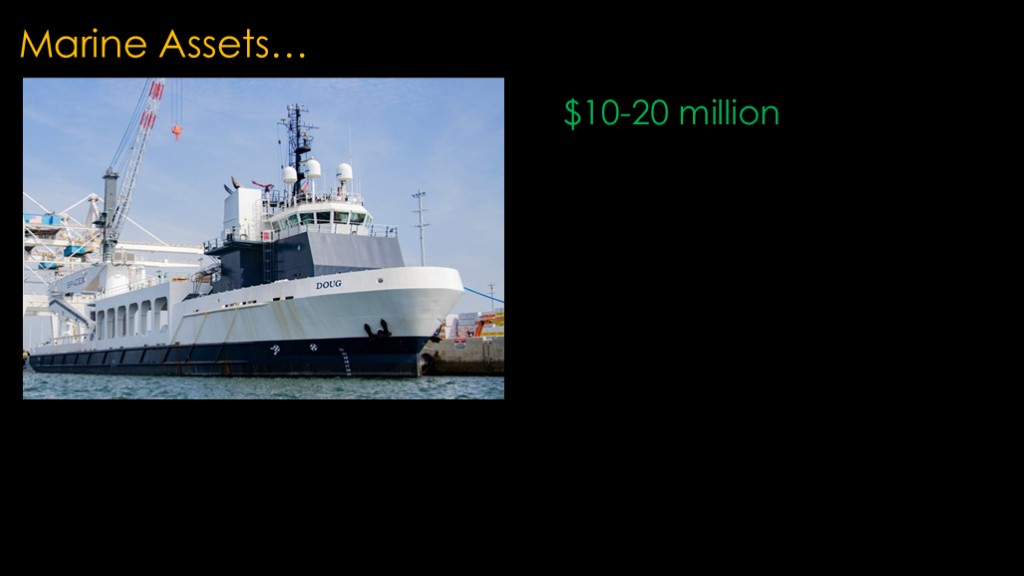
Marine assets are also expensive...
Bob and Doug probably cost $10-20 million per year each, and the drone ships costs are likely similar, perhaps more because of the need to pay tug companies to move them around.
And they costs almost the same tied up to the dock if you aren't flying.
Marine assets add a lot of complexity and uncertainty to your life.
Let's talk about Starship.
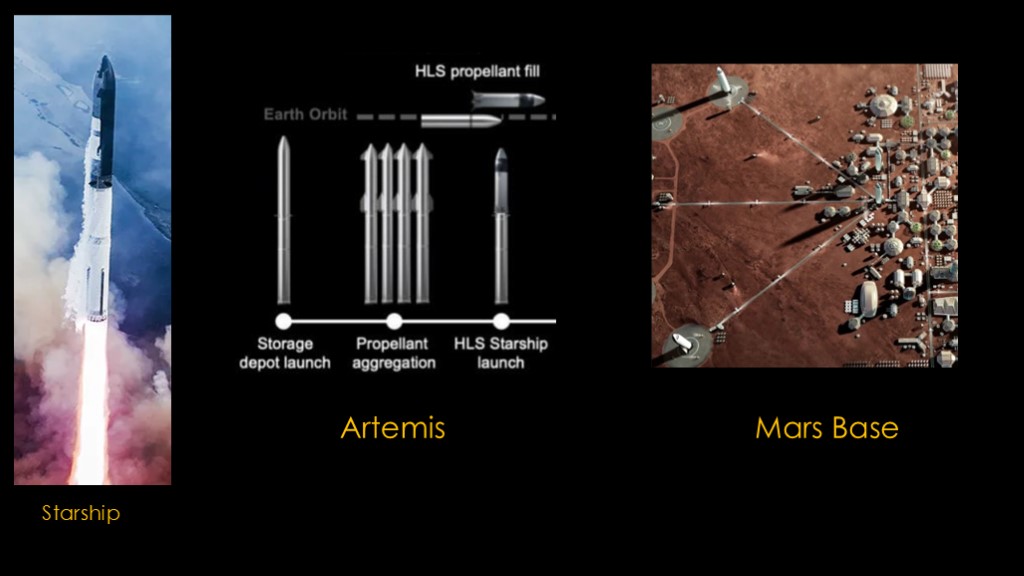
The two big goals for starship - outside of Starlink launches - are to support NASA's Artemis program and future Mars exploration.
Both of those require what NASA calls propellant aggregation - you need to fly a bunch of missions to carry enough fuel into orbit to refuel the mission starship, which means you need to fly often.
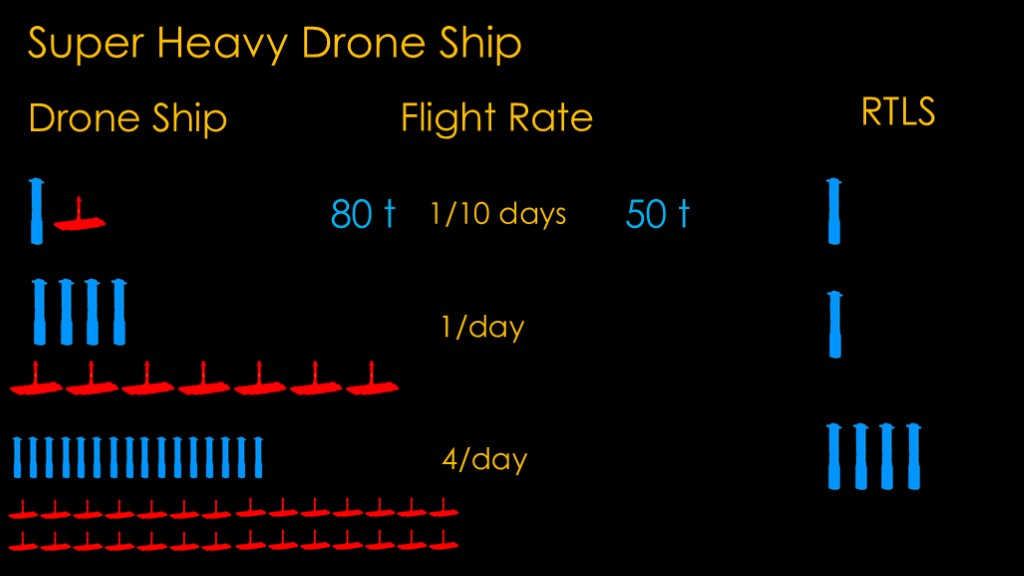
With that in mind, let's explore what a few different scenarios would mean to super heavy. I'm going to assume that super heavy has rapid turnaround and can fly once a day.
The Falcon 9 drone ship approach can support a flight rate of about once in every 10 days. Using Starship 1 numbers, that flight could carry about 50 tons of payload if flown RTLS. If we add a drone ship to that, my model estimates we can carry about 80 tons of payload. That seems like a no brainer in terms of payload, but remember that we don't have expendable second stages to deal with and - assuming starship works the way it should - our big cost is fuel cost. Having said that, if you are flying once every 10 days the drone ship is probably a win.
But remember that both the moon and mars missions need refueling, and you are going to want to do those as quickly as possible. 100 days for 10 flights will not be acceptable, and more than 10 flights might be required.
With RTLS, we can fly a mission every day with a single super heavy. But the drone ship approach has a problem. At best, they have a cycle time of 5 days so we need 5 of them to fly once a day, but we might need 10 of them to do this on a sustained basis. 7 is a reasonable minimum if you are very organized, get lucky with the weather, and can accept downtime after a fast surge of missions.
We also need more super heavy boosters because some of them are stuck on the drone ships coming back or being transported from the dock to the launch site. I'm going to say you need 4.
Flying once a day now requires 4 super heavy boosters and 7 drone ship groups, and that's if you get lucky. That payload advantage no longer seems attractive; it's pretty likely that you can fly an extra mission a day to exceed the drone ship payload and spend a lot less than those drone ships cost. And you have to purchase those custom drone ships and find a place to store all your vessels because port Canaveral does not have room.
And let's say you have a refueling mission that can take 2 flights a day and you have two others you need to fly as well, bumping your flight rate to 4 times per day. You need four super heavies for RTLS, but you need 16 super heavies for the drone ship approach and 28 drone ship groups.
The point of these scenarios is pretty simple. Drone ships are fine at low flight rates but if you want to fly all the time - which is what SpaceX wants to do with starship - the slow cycle times just kill you.
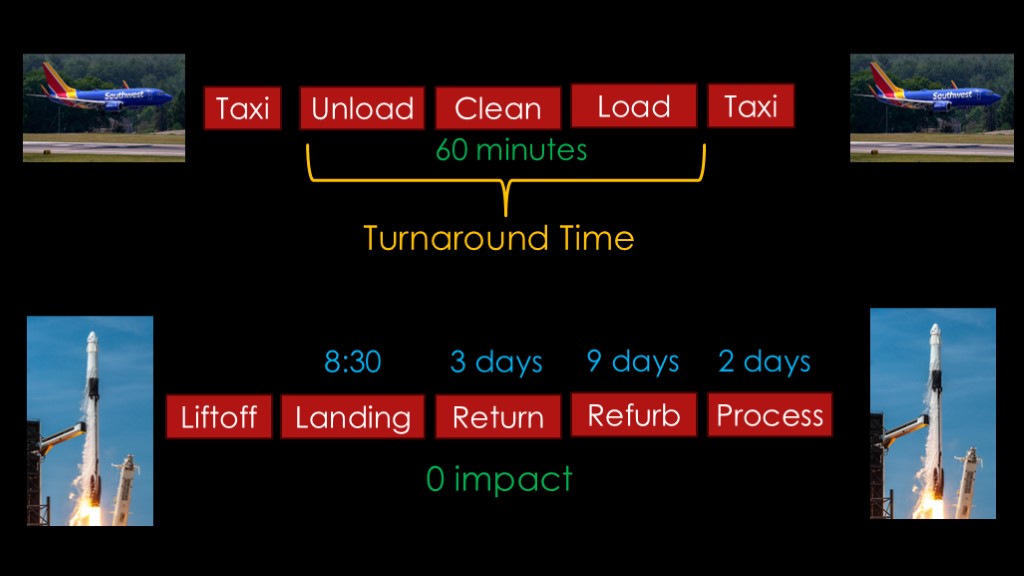
Airlines are masters at high utilization. When the plane lands, it taxies to the gate, and then the airline unloads people and cargo, cleans the cabin, loads people cargo and fuel, leaves the gate, taxies, and takes off. That time in the middle is known as turnaround time and airlines minimize it because they only make money when planes are flying. A good airline will do that in about 60 minutes.
Most airliner are working about 11 hours a day, every day.
For Falcon 9, the time from liftoff to drone ship landing is about 8 and a half minutes, then things slow down. A couple of days to get back to port, 9 days to do the refurbishment and inspection is supposedly the fastest they've done, and then presumably a couple of days to get a new fairing attached and ready to fly.
The fastest that SpaceX has every reflown a booster is 27 days, which they have done twice. What that means is that the return time because of drone ships is a small proportion of the total cycle time, and SpaceX isn't even trying to minimize the time to refly boosters quickly. The time that boosters spend on the drone ships has pretty much zero impact on the overall cycle time.
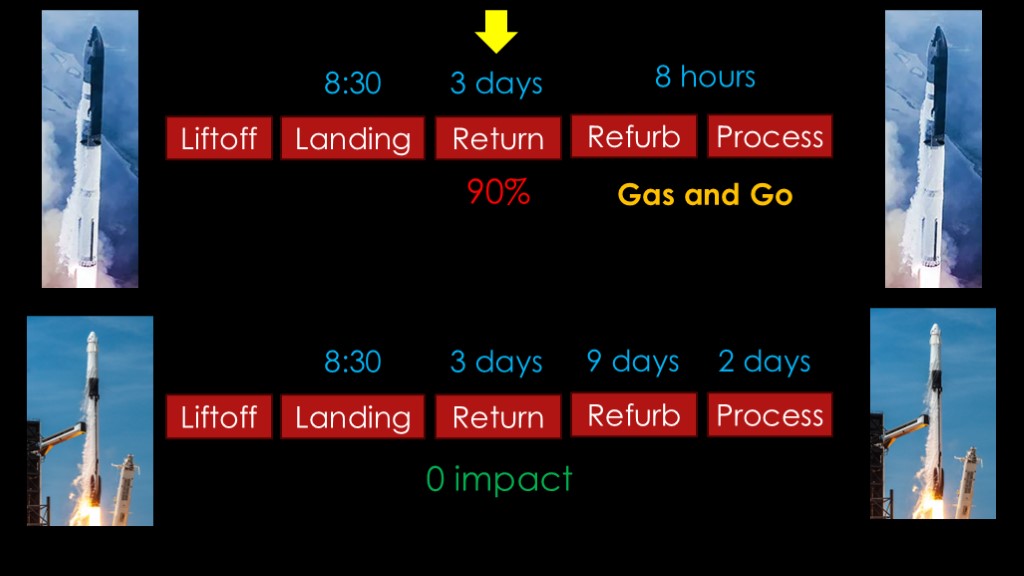
Starship is a different beast; the SpaceX goal is for "gas and go" operation of super heavy, with inspection and propellant loading taking place almost immediately after landing. Let's say for sake of argument they can do it in 8 hours.
You have probably already figured out the issue. That 3 days spent on the drone ship is 90% of the time between flights, and because it's transit time there's very little you can do about it. You can maybe do 4 day cycle times on each booster, if the weather is good and if you don't have mechanical issues with the marine assets.
This is the real reason why Starship uses return to launch site.
It's expensive in terms of payload, but it is the only way you can get truly rapid turnaround, and that is required for the Starship missions.
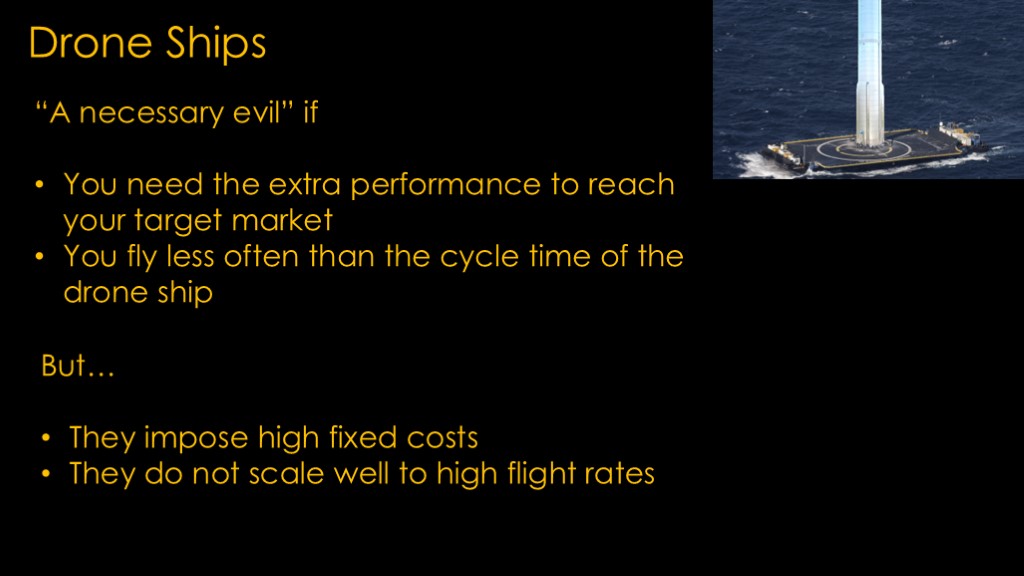
What did we learn?
Drone ships are a necessary evil if you need the extra performance to reach your target market, and as long as your launch cycle time is less than the cycle time of the drone ship.
But they have high fixed costs and do not scale well to high flight rates.
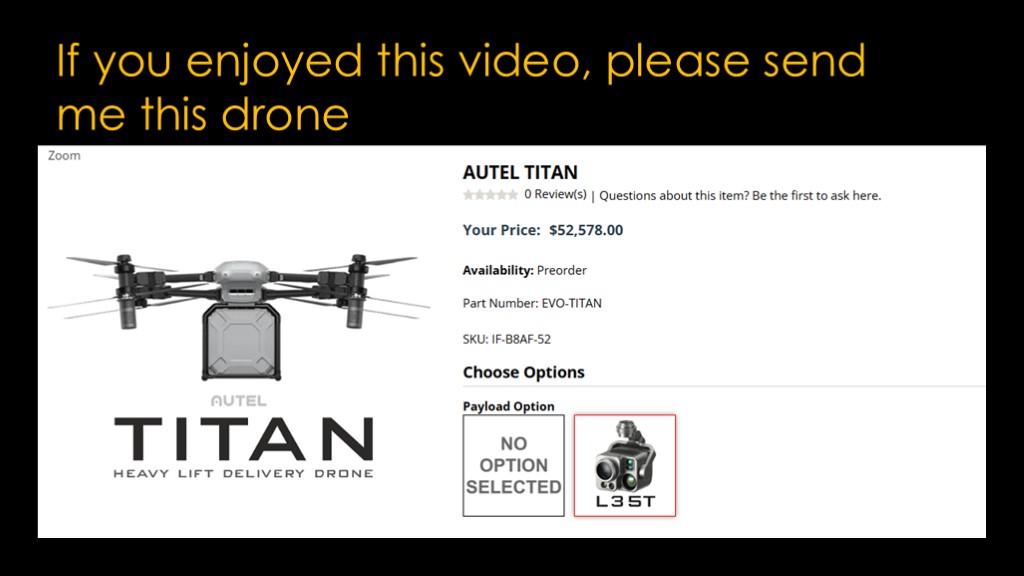
If you enjoyed this video, please send me this Autel titan drone